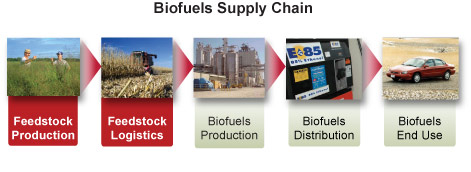Biomass Feedstocks
Biomass includes all plants and plant-derived material, and is a sustainable feedstock for the production of transportation fuels, products, and power.

The success of the U.S. bioindustry depends, to a large degree, on the quantity and quality of biomass available, and on the industry's ability to cost-effectively utilize biomass for energy production. Therefore, the Biomass Program's Feedstock R&D Platform impacts all facets of the Biomass Program portfolio. The Feedstock Platform is specifically linked to Processing and Conversion Platforms, as feedstock is the substrate that serves as a beginning point for all conversion technologies.
Ensuring a sustainable, high-quality, available, and functional supply of biomass feedstock requires R&D on all elements of the biomass feedstock supply chain, from plant breeding and genomics to crop production and harvesting techniques. The Biomass Program relies heavily on its Program partners, including the DOE Office of Science, the U.S. Department of Agriculture (USDA), the National Laboratories, and many academic and industrial institutions that each play a role in advancing feedstock technologies from basic plant sciences to harvesting.
The Biomass Program's Feedstock Platform focuses on two areas of the feedstock supply chain: Sustainable Feedstock Production and Feedstock Logistics.
Sustainable feedstock production includes all the steps required to produce biomass feedstocks to the point they are ready to be collected or harvested from the field or forest. OBP's feedstock production R&D is focused on identifying feedstock resources, selecting the best feedstocks for energy production and solving specific feedstock production issues on a regional basis.
Feedstock logistics encompasses all the unit operations necessary to move biomass feedstocks from the field or forest to the biorefinery, while ensuring the delivered feedstock meets biorefinery specifications. OBP's feedstock logistics R&D is focused on developing and optimizing cost-effective, integrated systems for collecting, storing, preprocessing and transporting a range of cellulosic feedstocks, including agricultural residues, forest resources and dedicated energy crops.
These efforts will lead to completion of the Feedstock Platform's strategic goal: to develop sustainable technologies that can provide a secure, reliable, affordable and sustainable cellulosic biomass feedstock supply for the U.S. bioindustry in partnership with USDA and other key stakeholders. The ultimate outcome, or result, of the Feedstock Platform is that technologies and methods will exist to produce and supply over one billion tons per year of biomass feedstocks in a sustainable and cost-effective manner in the U.S.
Current Feedstock Related Links

















